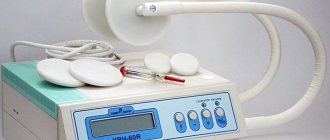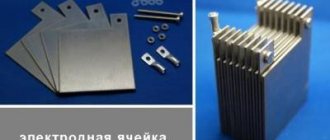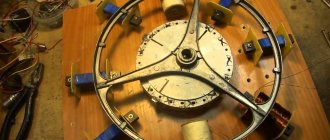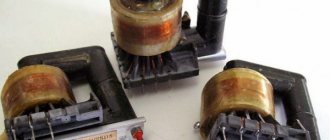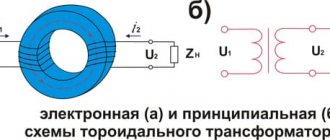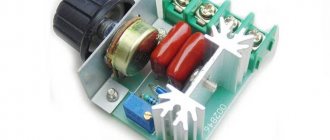Hydrogen is an almost ideal fuel for our planet. The only problem is that it is found on the planet only in combination with other substances. In its pure form, hydrogen on Earth is only 0.00005%. In this regard, the issue of designing hydrogen generators is very relevant. Do not forget that hydrogen is an endless source of energy, practically located under our feet.
Design and principle of operation of a hydrogen generator
How it works
A classic apparatus for producing hydrogen includes a tube of small diameter, often with a circular cross-section. Under it there are special cells with electrolyte. The aluminum particles themselves are located in the lower vessel. The electrolyte in this case is suitable only for the alkaline type. A reservoir is installed above the supply pump where condensate collects. Some models use 2 pumps. The temperature is controlled directly in the cells.
The generator receives gas from water. Its quality directly affects the amount of impurities in the finished product. So, if water with a high concentration of foreign ions enters the generator, it will first have to pass through a deionization filter.
Here's how the gas production process works:
- The distillate is split into oxygen (O) and hydrogen (H) through the process of electrolysis.
- O2 enters the feed tank and then escapes to the atmosphere as a byproduct.
- The H2 is supplied to the separator, separated from the water, which is then returned to the feed tank.
- The hydrogen is re-passed through a separation membrane, which extracts the remaining oxygen from it, and then enters the chromatography equipment.
Electrolysis method
As mentioned above, there are practically no inexhaustible energy sources in the world like hydrogen. We should not forget that 2/3 of the World Ocean consists of this element, and in the entire Universe, H2 coupled with helium occupies the largest volume. But to get pure hydrogen, you need to split water into particles, and this is not very easy to do.
Scientists, after many years of tricks, invented the electrolysis method. This method is based on placing two metal plates in water at a close distance from each other, which are connected to a high voltage source. Next, power is applied - and the high electrical potential actually breaks the water molecule into components, resulting in the release of 2 hydrogen atoms (HH) and 1 oxygen (O).
Expert advice
Qualified craftsmen believe that making homemade hydrogen generators for cars at home is a risky endeavor.
They explain this by the fact that an electrolyzer for a car has a complex and unsafe system of devices.
The manufacture of such units requires the use of special materials and reagents.
Please note: in the case of self-installation of an electrolyser that was made by yourself, it is recommended to strictly exclude the possibility of gas entering the combustion chamber when the engine is turned off. When the engine is turned off, the hydrogen generator must automatically disconnect from the vehicle's electrical power supply.
If you still decide to make a car hydrolyzer yourself, then you should definitely equip it with a bubbler - this is a special water valve. Using it will significantly increase safety when driving a car.
Hydrogen Generator Application Area
H2 is a modern energy carrier that is actively used in many industrial areas. Here are just a few:
- production of hydrogen chloride (HC)l;
- production of fuel for rocket launchers;
- ammonia production;
- metal processing and cutting;
- development of fertilizers for summer cottages;
- synthesis of nitric acid;
- creation of methyl alcohol;
- food industry;
- production of hydrochloric acid;
- creation of "warm floor" systems.
In addition, HHO has become very useful in everyday life, although with reservations. First of all, it is used for autonomous heating systems. In addition, Brown's gas is added to gasoline in an attempt to trick the engine and save on fuel.
What water should I use – distilled or tap water?
There is nothing complicated here. Tap liquid can be used, but only if it does not contain heavy metal impurities. But in order for the equipment to work more efficiently, it is better to use distilled water, adding a small amount of sodium hydroxide to it. The ratio in this case should be as follows: a tablespoon of hydroxide for every ten liters of water.
What is needed to make a fuel cell at home
Creating a hydrogen unit at home is not an easy task. You need to arm yourself not only with a number of tools, but also with relevant knowledge and diagrams.
Hydrogen generator design: diagrams and drawings
The device consists of a reactor with installed electrodes, a PWM generator for power, a water seal, wires and hoses connecting the structure. Today, several electrolyzer designs are known, where plates or tubes are used as electrodes.
Dry electrolysis devices are also popular. Unlike the classic version, in this unit the plates are not placed in a container with liquid, but the water itself is directed into the gap between the flat electrodes.
Selection of materials for the construction of a hydrogen generator
To make a generator at home, you do not need any special or unusual tools. Here's what you need to prepare:
- hacksaw for working with metal products;
- drill and drill bits for it;
- set of wrenches;
- flat and slotted screwdrivers;
- angle grinder (“grinder”) with a circle for cutting metal;
- multimeter and flow meter;
- ruler;
- marker.
What kind of metal should I use?
This issue is controversial. Thus, many - including very authoritative - sources say that only rare metals must be used for hydrogen heating. In reality, this is not entirely true, since it is quite possible to use stainless steel, as we have already discussed above. Although ideally it should be ferrimagnetic steel. It differs in that it does not attract particles of unnecessary debris. We also note that when choosing a metal, it is better to focus on “stainless steel”, which is not subject to the oxidation process.
As you can see, building a hydrogen boiler is not as difficult as it seems. You just need to choose the right consumables and carefully study the diagram of a heating system of this type. After installing all the necessary equipment, check it to make sure that it is really of high quality and sufficiently effective.
Video - Making a hydrogen generator
DIY hydrogen generator: instructions
The process starts with the creation of a hydrogen production cell. In terms of dimensions, it should be slightly less than the internal parameters of the length and width of the generator housing. In height it is 2/3 of the height of the main building. The cell is made of PCB or plexiglass (wall thickness 5-7 mm). To do this, 5 plates are cut to size, from which a rectangle is glued, and its lower part is not covered with anything.
Using a grinder, electrode plates are cut out of a stainless steel sheet. They should be 10 - 20 mm smaller in size than the side walls.
IMPORTANT ! To obtain a sufficient amount of HHO, stainless steel should be sanded on both sides.
It is necessary to drill 2 holes in each plate: to supply water into the space between the electrodes and to remove Brown's gas.
Types of installations
Today, a hydrogen generator for a car can be equipped with three electrolyzers that differ in type, nature of operation and performance:
- Simple, cylindrical type. Produces 700 milliliters of gas per minute. This performance is sufficient for engines with a displacement of up to 1.4 liters.
- With cells of separate type. It is the most efficient in terms of design and performance. The gas output exceeds 2 liters per minute. This volume allows it to be used in freight transport.
- Electrolyzer with open plates. This design provides additional cooling to the system, as a result of which it can be used during long-term operation of the unit. The gas output is controlled by the number of reactor plates.
The first type of design is quite sufficient for many carburetor engines. There is no need to install a complex electronic circuit for a gas performance regulator, and the assembly of such an electrolyzer itself is not difficult.
For more powerful cars, it is preferable to assemble the second type of reactor. And for engines running on diesel fuel and heavy-duty vehicles, a third type of reactor is used.
Hydrogen at home: is there any benefit?
Let us note right away: using a hydrogen generator to heat a house is unprofitable. You will spend more electricity releasing pure H2 than you will gain from burning it. So, 2 kW of electricity is consumed for 1 kW of heat, that is, there is no benefit. It is easier to install any of the electric boilers at home.
To replace 1 liter of gasoline for a car, you will need 4766 liters of pure hydrogen or 7150 liters of detonating gas, 1/3 of which is oxygen. So far, even the best minds in the world have not developed a unit capable of delivering such performance.
Device selection
When choosing a hydrogen generator, the price of the model usually reflects its capabilities. The more there are, the more convenient the device is for regular use. The most important parameters include:
- Microprocessor control for precise setting of operating parameters.
- Quality of purification of the finished product: it is desirable that the equipment supports multi-stage preparation of H2.
- The efficiency of the electrolyser: the higher it is, the less energy is spent on maintaining the splitting of water.
- Possibility of topping up distillate without turning off the device to ensure process continuity.
- Sophisticated protection against increased current in the electrolysis chamber or in case of excess pressure in the supply pipes. It is optimal if the device immediately turns off or automatically changes operating parameters.
- Adjustable performance H2. The presence of this function allows the operator to control the volume of gas generated. The load on the electrolyzer is reduced, its service life is increased without the need for replacement.
- Temperature control of the oxygen afterburner. The more parameters that allow you to adjust the pure hydrogen generator, the easier it is to debug the production process.
- Indication of the humidity of the substance (eliminates the risk of moisture entering the supply lines).
There are other parameters that it is recommended to pay attention to before buying a hydrogen generator: price of the device, productivity, degree of gas purification, pressure stability, water content of the finished substance, ramp-up time, power consumption and dimensions.
Compliance with safety measures
The electrolyzer is a high-risk device.
Therefore, during its manufacture, installation and operation, it is imperative to observe both general and special safety measures.
Special measures include the following:
- the concentration of the mixture of hydrogen and oxygen should be controlled in order to prevent an explosion;
- if the liquid level is not visible in the inspection window of the hydrogen generator, then it cannot be used;
- When performing repairs, you need to make sure that there is no hydrogen at the end point of the system;
- the use of open fire, electric heating devices and portable lamps with a voltage of more than 12 volts near the electrolyzer is contraindicated;
- When working with electrolyte, you should protect yourself by using protective equipment (overall clothing, gloves and goggles).
Material balance
| Product name | Measurement | Day | |
| unit | total | % | |
| Inputs | |||
| Feed gas | T | 276,00 | 22,30 |
| HP steam consumption in pre-reforming | T | 633,60 | 51,20 |
| HP steam consumption in reforming | T | 327,90 | 26,50 |
| Amount of raw materials | T | 1 237,50 | 100,00 |
| Exits | |||
| Hydrogen from the plant | T | 89,70 | |
| Stripping gas flow from the PSA unit to the furnace | T | 605,10 | |
| Process condensate consumption | T | 542,70 | |
| Sum of products | T | 1 237,50 | |
General information.
Since the late 80s, the limited liability company "Institute of Physico-Technological Research (IPTI)" (IPTI LLC) has been developing, producing and introducing modern hydrogen electrolysis plants of the FS-T.25 series at industrial facilities.
The first installation of the FS series was installed at GRES-24 MOSENERGO in Novomichurinsk (Fig. 1), now Ryazanskaya GRES.
FS series units are designed and manufactured according to TU 3610-002-13151350-08 (until 2007 - according to TU 3610-002-13151350-99) for energy needs (hydrogen cooling of turbine generator windings at thermal power plants, state district power plants and nuclear power plants), electronics and others industries (metallurgy, petrochemistry, glass and food industries, as well as medicine).
The installations are protected by Russian Federation patents and have:
- Declaration of conformity of installations TR TS 004/2011, 010/2011 and 020/2011,
- Certificate of conformity and declaration of equipment for installations TR TS 032-2013 “On the safety of equipment operating under excess pressure”,
The installations meet the requirements:
- Safety rules for the production of hydrogen by electrolysis of water (PB 03-598-03),
- Standard instructions for the operation of electrolysis plants for the production of hydrogen and oxygen (RD 34.50.501-96, RAO UES of Russia),
- Federal Law of the Russian Federation of July 22, 2008 No. 123-FZ “Technical Regulations on Fire Safety Requirements”,
- General explosion safety rules for fire and explosion hazardous chemical, petrochemical and oil refining industries (PB 09-540-03).
The devices of the FS series installations are not subject to the “Industrial Safety Rules for Hazardous Production Facilities that Use Equipment Operating under Excessive Pressure”, Order No. 116 of Rostechnadzor dated March 25, 2014, Chapter 1, paragraph 4, paragraph “p”.
Other.
- Electricity costs for hydrogen production are no more than 5.0 kW*h/Nm3.
- Structure of maintenance and repair cycles for the FS-T.25 installation:
- TO-1 - with the unit turned off, once a month.
- TO-2 - with the unit turned off, once every 6 months.
- TO-3 - with the unit turned off, once a year.
- TO-4 (current repairs) - with the unit turned off, once every 3 years.
- TO-5 (overhaul) - with the unit switched off, once every 10 (6) years*.
* In accordance with clause 6.22.1.3 STO 70238424.27.100.050-2009 “Electrolysis installations of power plants. Organization of operation and maintenance. Standards and requirements" major repairs must be carried out once every 6 years.
Installations of the FS-T.25 series are subject to major repairs once every 10 years, subject to technical maintenance by the service department of IFTI LLC.
Reliability indicators:
- MTBF, hour, not less than 10,000.
- Lifetime before first major overhaul, hour – 42,000 + 2,000.
- The period between current repairs is at least an hour - 8,000.
- Service life of the main process equipment, years, not less than 20.
- The electrolysis plant is powered from existing 0.4 kV switchgear in accordance with the requirements of the Electrical Installation Regulations.
